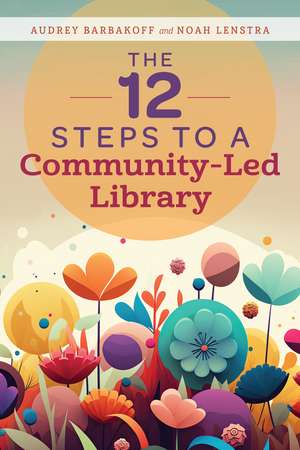The 12 Steps to a Community-Led Library
Autor Audrey Barbakoff, Noah Lenstraen Limba Engleză Paperback – 17 dec 2023
- introduces the foundations of community-led planning, including what it means, why it matters, and how to do it;
- takes you through a twelve-step process, adaptable to libraries of any size or budget and serving any type of community, to fundamentally shift your organization towards more equitable and community-centered ways of thinking;
- presents strategies for success, pitfalls to avoid, lessons from case studies, and key takeaways for each step; and
- offers tools to assess your organization’s capacity, evaluate your progress, adapt, and troubleshoot.
Preț: 385.11 lei
Nou
Puncte Express: 578
Preț estimativ în valută:
73.69€ • 76.14$ • 61.30£
73.69€ • 76.14$ • 61.30£
Carte tipărită la comandă
Livrare economică 19 martie-02 aprilie
Preluare comenzi: 021 569.72.76
Specificații
ISBN-13: 9780838936122
ISBN-10: 0838936121
Pagini: 216
Dimensiuni: 152 x 229 x 18 mm
Greutate: 0.26 kg
Editura: American Library Association
Colecția ALA Editions
ISBN-10: 0838936121
Pagini: 216
Dimensiuni: 152 x 229 x 18 mm
Greutate: 0.26 kg
Editura: American Library Association
Colecția ALA Editions
Notă biografică
Audrey Barbakoff is the CEO of Co/lab Capacity LLC, which provides community-centered consulting for libraries and social good organizations. During more than a decade in public libraries, her work was recognized by Library Journal Movers & Shakers, the Urban Libraries Council Top Innovators, and the Freedom to Read Foundation. Dr. Barbakoff holds an MLIS from the University of Washington and an EdD in Organizational Change and Leadership from the University of Southern California. She is the author of Adults Just Wanna Have Fun: Programs for Emerging Adults and the forthcoming picture book The Schlemiel Kids Save the Moon.
Noah Lenstra is an associate professor of library and information science at the University of North Carolina at Greensboro, where he brings a community organizing approach to the teaching and research of public librarianship. Since 2016, Dr. Lenstra has managed the Let’s Move in Libraries initiative, an online space for sharing stories and resources related to public library participation in community health initiatives related to food or physical activity. Dr. Lenstra holds doctoral and master’s degrees in library and information science from the University of Illinois at Urbana–Champaign.
Noah Lenstra is an associate professor of library and information science at the University of North Carolina at Greensboro, where he brings a community organizing approach to the teaching and research of public librarianship. Since 2016, Dr. Lenstra has managed the Let’s Move in Libraries initiative, an online space for sharing stories and resources related to public library participation in community health initiatives related to food or physical activity. Dr. Lenstra holds doctoral and master’s degrees in library and information science from the University of Illinois at Urbana–Champaign.
Cuprins
Introduction: The Community Is the Heart of the Library
Part I: Foundations
Chapter 1: Community-Led Planning 101: What it Means and Why it Matters
Chapter 2: Relationship to Equity, Diversity, Inclusion, and Social Justice
Chapter 3: How to Conduct Community-Led Planning
Chapter 4: Assessing your Library’s Community-Led Capacity
Chapter 5: The Community-Led Capacity-Building (CoLaB) Model
Part II: Phase One: Inspirational Change
Step 1: Set Clear Expectations
Step 2: Train for Understanding, Not Procedure
Step 3: Connect to Core Values
Part III: Phase Two: Transformational Change
Step 4: Foster a Growth Mindset
Step 5: Develop Psychological Safety for a Culture of Inclusive Innovation
Step 6: Make Time and Space for Reflection
Step 7: Prioritize Interpersonal Skills and Cultural Humility
Step 8: Apply Prior Knowledge
Step 9: Build Community Knowledge through Relationships
Part IV: Phase Three: Operational Change
Step 10: Give Staff Time and Authority to Build Relationships
Step 11: Make It Everyone’s Work
Step 12: Measure Success through Relationships
Part V: Evaluating, Adapting, and Troubleshooting
Conclusion: Moving Forward and Coming Back
Index
Part I: Foundations
Chapter 1: Community-Led Planning 101: What it Means and Why it Matters
Chapter 2: Relationship to Equity, Diversity, Inclusion, and Social Justice
Chapter 3: How to Conduct Community-Led Planning
Chapter 4: Assessing your Library’s Community-Led Capacity
Chapter 5: The Community-Led Capacity-Building (CoLaB) Model
Part II: Phase One: Inspirational Change
Step 1: Set Clear Expectations
Step 2: Train for Understanding, Not Procedure
Step 3: Connect to Core Values
Part III: Phase Two: Transformational Change
Step 4: Foster a Growth Mindset
Step 5: Develop Psychological Safety for a Culture of Inclusive Innovation
Step 6: Make Time and Space for Reflection
Step 7: Prioritize Interpersonal Skills and Cultural Humility
Step 8: Apply Prior Knowledge
Step 9: Build Community Knowledge through Relationships
Part IV: Phase Three: Operational Change
Step 10: Give Staff Time and Authority to Build Relationships
Step 11: Make It Everyone’s Work
Step 12: Measure Success through Relationships
Part V: Evaluating, Adapting, and Troubleshooting
Conclusion: Moving Forward and Coming Back
Index
